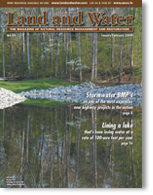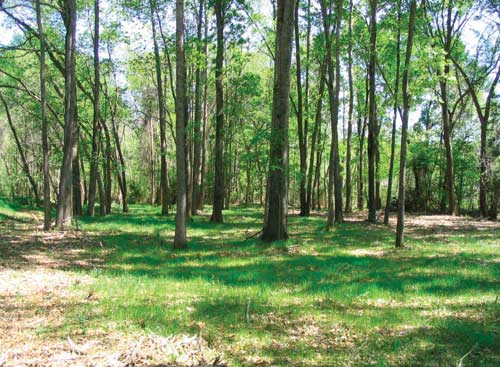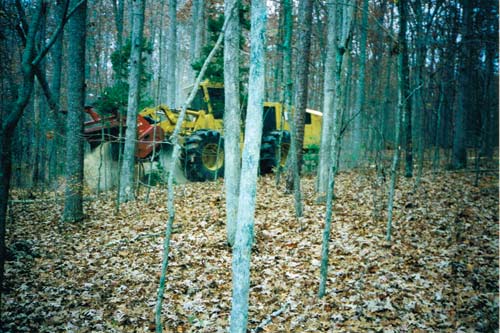A Novel Approach to Flood Management Saves City Millionsby Jim Wahl, President of Wahl Marketing Communications, and Shawn Hara, City of Longview, Texas |
A novel approach to flood management saved the city of Longview, Texas millions of dollars while preserving the natural beauty of the area. Nearly 6 miles of Grace Creek flows through downtown Longview before it empties into the Sabine River. Much of the land along the river is nearly flat and is prone to frequent flooding. A heavy overgrowth of brush inhibited the flow of floodwaters and raised upstream water levels. To reduce flooding, the Grace Creek Floodplain Management Project sought to reduce the 100-year flood levels of Grace Creek by as much as 2.2 feet. Two options were initially considered. The first was a structural option that would require the construction of a drainage channel from 55 to 75 feet wide to rapidly remove floodwaters from the area. While effective, this option would have dramatically (and adversely) impacted the natural setting of the Grace Creek area and the wildlife therein. This coupled with a hefty price tag of more than $20 million prompted the city to seek an alternative. A second option called for removing the existing underbrush and allowing the remaining hardwoods to develop into a mature forested floodplain with complete tree canopy coverage. This option was selected because it still mitigates the floodwater damage, yet does so without compromising the natural beauty of the area. A Two-Phased Approach
Throughout the project, emergent wetlands, creeks and intermittent drainage areas remained undisturbed. Phase 1 focused on Lower Grace Creek. Terry Anderson and J. Mike Bird of Advanced Ecology Inc., an environmental and natural resources consulting firm in Center, Texas were selected as the local contractors. Bird recalls that the project “had a tremendous amount of brush and hardwood (undergrowth). We were able to remove the vegetation without being intrusive and without a lot of soil disturbance.” Phase 2 focused on Upper Grace Creek. While similar in the scope of work to be done, there were no areas to be cleared and reforested. The Right Equipment Was Essential The selective thinning was a bit trickier. Bird said, “We saw that there was a need for a smaller machine - so we ordered a Franklin 3650; it’s a 3-wheeled piece of equipment.” This 200-horsepower machine features a slightly smaller mulcher. Its enhanced maneuverability was ideal for getting around the reserved trees, while removing the undesirable trees and underbrush. With any equipment, durability and service life are the keys to productivity – in harsh working conditions like the Grace Creek Floodplain Project – they are even more critical. Bird said “We had an opportunity to lease a couple of 450 horsepower machines with flail type heads on them. They were a maintenance nightmare.” “At the end of an 8-week period,” Bird continues, “we looked back on the production – the amount of time that we were actually running the flail hammers versus the Fecon. On a per-machine basis the Tigercat and Fecon combination were four times more productive than a swinging flail machine. (You) can’t attribute all of that to the head because there were some other mechanical problems, but a considerable amount of it can be directly related to how well the head services.”
Dramatic Results The project allowed for the preservation of this natural setting and afforded many opportunities for recreation and natural resource education. One such opportunity the establishment of Paul G. Boorman Pedestrian and Bicycle Trail, scheduled for completion in February 2006. The park will benefit Longview area citizens by becoming a transportation alternative for bicycle and pedestrian traffic that normally travel on nearby roadways. In addition, a scenic, improved pathway system will provide access to those who enjoy observing and studying nature. It is also anticipated that the addition of new trails in Longview will expand the opportunities for physical activity. By offering this unique opportunity for nature study, it is hoped increased tourism will result in economic benefits to the area. Time or money costs: Purchase of 810 acres of Floodplain property = $1.5 millionTotal Engineering Costs: $233,700 Phase 1: Southern Section (FM 1845 to US Hwy 80) Phase 2: Northern Section ( US Hwy 80 to Loop 281) Total Estimated Cost of Project excluding Maintenance = $2.5 million vs. $20 million (estimated for Option 1) A community working together For more information contact Fecon at www.fecon.com, info@fecon.com, (800)528-3113 or contact Advanced Ecology at www.advancedecologyinc.com, info@advancedecologyinc.com or contact Wahl Marketing at www.wahlmarketing.com, jim@wahlmarketing.com. |
©2006 - 1998 Land and Water, Inc.



